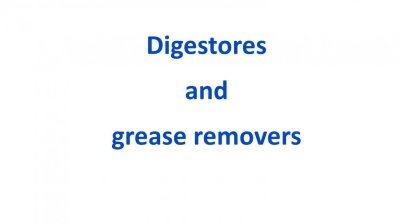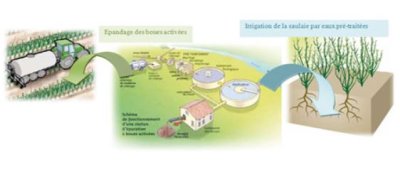1) What is involved ?
Stabilisation ponds involve treating wastewater in sealed ponds with micro-organisms or aquatic plants.
It a biological, and thus ecological and environmentally friendly, treatment process, facilitated by sunlight. It is a reliable, advantageous and fairly inexpensive alternative to the more conventional physical/chemical treatment of normal treatment plants and is even more effective in eliminating pathogenic substances.
Stabilisation pond systems optimise the treatment of pollution, which rather than stifling nature, nourishes it. They consist of artificial ponds, which can be used separately but are usually connected in series to improve their effectiveness.
2) Who use this means and since when ?
While stabilisation pond principles have been used for several centuries, stabilisation ponds have, since the beginning of XXth century, developed in many countries including the United States, Canada and Australia, Europe and now in developing countries.
This technique is well suited to the treatment of domestic and industrial effluents and while it will work on most continents, it is most effective in a fairly temperate climate, which is not too dry. The large areas required to use stabilisation ponds make this technique more advantageous in rural and industrial areas, or on the outskirts of towns where the cost and availability of land are not a restriction
3) What does this process involve ? How is it used ?

Small stabilisation ponds - Photo by CETE-UFRJ
Stabilisation ponds involve passing wastewater at a very low flow rate through a series of sealed ponds large enough to ensure that the water remains there for several days or even weeks.
The peculiarity of these ponds is that they contain bacteria that have the ability and time to degrade pollutants without external action. This degradation of organic matter into mineral substances (CO2, water, nitrates and phosphates) takes place through a natural, biological process either anaerobically (without oxygen) or aerobic (with oxygen) according to the pond.
There are four types of stabilisation ponds :
- Anaerobic stabilisation ponds
- So-called "facultative" stabilisation ponds
- Aerobic (or maturation) stabilisation ponds
- High efficiency stabilisation ponds
Stabilisation pond treatment generally takes place by passing wastewater, after screening, degreasing and oil removal, through three or more successive ponds. The treatment generally begins in an anaerobic stabilisation pond, continues in a facultative stabilisation pond and ends in an aerobic stabilisation pond. This may optionally be replaced or followed by a high efficiency stabilisation pond.

Diagram by Lagunage.eu
The respective roles of the various types of stabilisation ponds :
Anaerobic and facultative stabilisation ponds are intended to eliminate as much BOD as possible from wastewater (75% in the most favourable cases).
BOD (Biological Oxygen Demand, expressed in mg/l) is a measurement unit reflecting an environment’s concentration in terms of biodegradable organic matter (domestic wastewater thus generally has a BOD of 200 to 300 mg/l).
Aerobic stabilisation ponds are primarily intended to complete the treatment by removing any residual pathogenic germs. At the outlet, the BOD can be 75% lower.
High efficiency stabilisation ponds which are more compact and require stirring equipment, are intended to improve treatment speed and effectiveness.
- "Anaerobic" stabilisation ponds are fairly deep ponds where degradation occurs in the absence of oxygen. To ensure this condition, the pond must be about 2.5 to 5 m deep. The water is not aerated, agitated or heated. Anaerobic degradation produces CO2 and methane. These stabilisation ponds provide a significant initial reduction in the BOD (up to 60%).
- "Facultative" stabilisation ponds are shallower (1.2 m to 2.4 m). "Aerobic" degradation takes place in areas close to the surface and "anaerobic" degradation in deeper areas, hence the name "facultative".
- "Aerobic" stabilisation ponds, sometimes called maturation stabilisation ponds, are aerated and water flows through them artificially, with air promoting the degradation of waste. Algae and plants feed off the elements dissolved by bacteria and grow through photosynthesis. Solid particles fall and are digested at the bottom of the stabilisation pond. They are usually quite shallow (less than 1.5 m) to allow light to support photosynthesis and purification. Aerobic ponds can be connected in series or divided into two parts, with the final part providing very low or zero aeration to allow the sedimentation of waste.
Although they are usually the last stage in the treatment, either a high efficiency stabilisation pond or aquaculture ponds, as sources of food and income, are sometimes added to them.
The total treatment time in the various ponds is at least one week and sometimes even a month or more.
"High efficiency" stabilisation ponds consist of pools only 30 cm to 60 cm deep. The water in them is slowly stirred by paddle wheels, which causes intensive production of algae and oxygen. The area required for pools of this type can thus be up to 5 times smaller than for other types of pools. They need, however, certain minimum solar radiation and temperature conditions.
Size and maintenance :
Several factors must be considered when designing the size of stabilisation ponds :
- effluent, population, flow, organic load and bacterial concentrations ;
- climate : temperature and sunshine, wind and evaporation, rainfall ;
- land : topography, geology and hydrogeology.
With the help of specialists, these data can be used to determine such things as the area, shape, depth and sealing of the ponds.
The sludge settled at the bottom of the ponds must be removed every 5 to 10 years. After treatment, this sludge can be used as compost for agriculture.
4) Variant : stabilisation pond treatment through constructed wetland ponds planted with microphyte and macrophyte plants
To improve stabilisation pond efficiency, use is often made of plants of this type, such as micro algae or water lettuce (microphyte) or floating plants or plants such as reeds (macrophyte) that have many natural purification capabilities. Macrophyte stabilisation ponds are very effective for the treatment of water containing solids and phosphorus. Microphyte lagoons are more suitable for water containing elements pathogens that may cause diseases.
5) Special difficulties and remedial action - Precautions to be taken

Stabilisation pond treatment station of the town of
Rochefort (France), one of the largest
If the land on which the pond is to be built is permeable, it has to be waterproofed with a coating of clay, compacted soil or impermeable material to prevent infiltration.
The station should preferably be pointed in a direction opposite the wind.
Care should also be taken to avoid any overflow due to rain water.
It is best to fence off the ponds to protect them from animals or individuals who might mistake them for fishing or swimming ponds and to prevent plants falling into them.
Any vegetation inherent in the making of stabilisation ponds should be removed regularly enough to allow as much light as possible into the ponds and to prevent it turning into a nest for insects such as mosquitoes.
6) Main advantages and drawbacks
a) Advantages
- Moderate construction costs mainly depending on land prices and soil types.
- Low operating and maintenance costs. No energy costs.
- Construction generating many jobs,
- Service life of 15 to 20 years. High efficiency.
- Lower quantities of sludge produced and greater reduction of pathogenic germs than in a conventional station,
- Easy operation and maintenance
- Good environmental integration,
- Possibility of reusing treated water for various needs such as irrigation.
b) Drawbacks
- Large areas of land required for pools. An area of at least 5 m2/inhabitant and usually 10 to 15 m2 per inhabitant is required.
- Slow purification process.
- Specialists are needed for their design and follow-up.
- Sensitivity to temperature changes, with efficiency reduced during the winter,
- Risk of unpleasant smells and the presence of insects if the station is poorly designed or poorly maintained.
7) Cost
The highest costs involved in stabilisation ponds are the costs of digging ponds, which require much labour and piping. This cost varies from region and from soil type to another since, if the soil is permeable, it has to be sealed. For aerobic stabilisation ponds, the costs of installing and running aeration and water circulation equipment are much higher than those of anaerobic and facultative stabilisation ponds.
Examples of costs :
- In Ghapet (Ivory Coast), the stabilisation pond treatment station built in 2002 (on about 0.8 ha and 180 m3/d) near a palm oil factory, cost €182,000. Its cost price per treated m3 is 0.3 cents of a euro.
- In Accra (Ghana West Tema), the much larger station built in 2005 (8.8 ha and 833 m3/d) cost almost a million euros. The cost price per treated m3 is 0.5 cents per m3
In general, the cost expressed in terms of user household is about €20 to 100 for construction and €5 to 40 per year for operating and maintenance costs.
8) Where to obtain further information?
a) Websites
- PS Eau (Water solidarity programme) : Publication of the following 2 Reports :
- one (43 pages) entitled "Recycling of wastewater through stabilisation ponds in developing countries"
http://www.pseau.org/epa/gdda/Actio...
- another (2-page summary) on the results of a survey in 16 stations in these countries :
http://www.pseau.org/epa/gdda/Actio...
- Eawag (Swiss Research Institute) and WSSCC (Water Supply and Sanitation Collaborative Council, Geneva). Illustrated encyclopaedia containing 151 pages on all sanitation techniques :
"Compendium of water treatment systems and technologies". (Pages 99 to 102 for stabilisation ponds)
http://www.pseau.org/outils/organis...
- Stabilisation ponds : Overview, a few pages long, of the stabilisation pond technique, available at :
http://www.lagunage.eu/index.php?ti...
- Globenet : "Environmentally-friendly stabilisation ponds", 16-page document explaining the stabilization pond techniques
http://globenet.org/preceup/fr/docs...
- Office of wastewater management (USA) : several fact sheets available, but in English ;
- on anaerobic stabilisation ponds : http://www.epa.gov/npdes/pubs/alago... ,
- on facultative stabilisation ponds : http://www.epa.gov/npdes/pubs/facla...
- on aerobic stabilisation ponds : http://water.epa.gov/scitech/wastet...
c) Bibliography
- PDM and PSEau SMC Methodological guide (concerted municipal strategies) : "Choosing suitable technical solutions for liquid waste disposal", which is a very interesting and informative 136-page illustrated guide produced by GRET, pages 126 to 127 deal with the issue of stabilisation ponds. This guide can be obtained from GRET (45 avenue de la Belle Hélène 94736 Nogent/Marne Cedex) (www.pseau.org)
9) Advice
If you want a more comprehensive view of wastewater treatment in various environments, also see the following fact sheets :
The General presentation Fact sheet A17 entitled "Various approaches to ecological effluent treatment as an alternative to conventional treatment plants",
Fact sheet A18 entitled "Bar screens and systems for spreading wastewater by scooping",
Fact sheet A19 entitled "Settlers/digesters",
Fact sheet A20 entitled "Macrophyte constructed wetland filters" and
Fact sheet A24 entitled "Individual or family self-contained sanitation system through stabilisation ponds".
















